
|
|
Jan. 19, 1999
Letter 9: Visitors
Dear Everyone,
Someone asked me not long ago if we receive any unexpected guests at
the Amundsen-Scott South Pole Station. Although they are never
unexpected, we do receive visitors. Our guests are comprised of
Trans-Antarctic expeditions, distinguished visitors (we call them
DVs), and a few tourists.
The Trans-Antarctic expeditions tend to generate the most excitement
and enthusiasm of all of our visitors. Ola Skinnarmo was our first
such guest. Ola is a 26-year old Swede who is the youngest person
ever to complete such an Antarctic expedition. He departed from
Hercules Inlet on the coast at the Weddell Sea on Nov. 5, 1998 and
skied the 1,500 km solo and unsupported (no airdrops of provisions) to
our station in only 47 days. He had enough food in his sledge for 58
days. Having good health with no frostbite and fairly good weather
for most of the journey, Ola looked like he'd simply gone out for an
afternoon ski. Les and I were part of the group of 10 people who
rushed off to the South Pole marker to welcome and congratulate him
when he arrived. Like most of our NGA (non-governmental activities)
guests, Ola agreed to give a presentation about his adventure. He
mesmerized a full house audience in our galley on Dec. 23rd with his
humor, life's turning point story triggering the conception of his
goals, his mental and physical training for this event and his tales
of survival alone on the ice. Throughout, Ola interspersed his candid
philosophy of life. If you follow such events, you may find him in
speaking engagements or media in the future. Ola's web site is in
Swedish at: http://www.sydpolen.com.
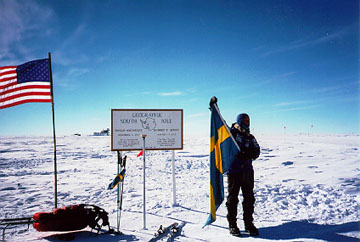
Ola Skinnarmo
Photo by Sandi Kolb.
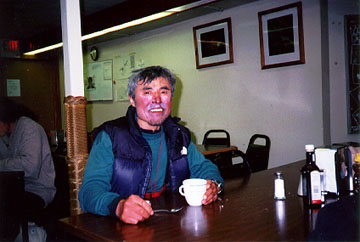
Ohba Mitsuro
Photo by Sandi Kolb.
Ohba Mitsuro, a 45-year-old Japanese adventurer and Trans-Antarctic
skier, arrived at the South Pole marker at exactly midnight on New
Year's Eve to little fanfare. When Les informed Ohba of his 12:00 a.m.
arrival time, it was both shocking and thrilling to him because it was
totally unplanned. I was working in Comms when a beaker called me
from the Clean Air Building (Atmospheric Research Observatory) to ask
if we were expecting someone. He said he spotted a skier pulling a
sledge coming our way. While most of the station danced the night
away to midnight revelry, Les rushed out to the South Pole with the
video camera to document his arrival. Later Les told me that he was
one of three people at the pole to greet Ohba and that he was the only
one to actually film Ohba's arrival. Once Les, Jerry, and Floyd
brought Ohba to the galley for some food, Les covered the radios for
me so I could dash over to congratulate him. Because Ohba experienced
frostbite his face was painful to see, but he radiated happiness.
Within 3 days he looked much better. Ohba was here for about one week
while he waited for his contracted expedition support agency to fly in
his resupply of food and other provisions by Twin Otter. The agency's
photographer also arrived on the Twin Otter for Ohba's photo shoot
before he skied off for the remainder of his Trans-Antarctic
expedition. Ohba, like Ola, was skiing solo but for a much greater
distance. Ohba began his adventure on Nov. 10th at Dronning Maud Land
via the South Pole to Fletcher Island, Ellsworth Land comprising a
total distance of 4,070 km. Ohba told me that his pick-up date out of
Antarctica was set for Feb. 20, 1999. When I expressed concern about
the lateness of the date and our quickly approaching winter, he was
not at all worried. If Ohba succeeds in his goal, he will become the
first person to complete solo treks across both Antarctica and the
frozen Arctic Ocean. In 1997, Ohba became the first person to solo
the Arctic after frostbite had taken all his toes in his 1995 attempt
to cross it. Because Ohba did not change to New Zealand time while
here, he frequently came to Comms to chat with Les and me during our
night shift. One night Les assisted Ohba with amateur radio
communications to Japan, his homeland. They made about 20 contacts
and had a fabulous time. Les says this is the philosophy of "ham"
radio at its best. I took several photos of this session. Ohba gave
me this address for his English web site:
http://ohba.online.co.jp/ohba/o-frm.htm. For the Japanese site go to:
http://ohba.online.co.jp/ and then scroll and click on the English
language icon. I visited Ohba's web site yesterday morning and was
both touched and astounded by his biography. Les and I sensed the
specialness of his personality and now we know why.
The French expedition of 5 skiers, Group Militaire de Haute Montagne
from Chamonix, France arrived at the South Pole on Jan. 10th around
8:30 a.m. Les and I were in Comms having just finished work,
breakfast, and putting on our ECW clothing when Martin called on his
hand-held radio saying he spotted the group. We immediately took off
for the South Pole practically running up Heartbreak Hill (also called
Heart Attack Hill and Cardiac Hill) from the dome and were by far the
first to arrive as they skied to the pole marker. Much handshaking
and chatter followed as Les filmed and I snapped photos first with our
cameras and then theirs. We never imagined that our French would be
so convenient here as it was when we welcomed and congratulated the
skiers at their arrival and talked to them about their adventures
during the following days. This French military ski group is a part
of the Mountain Division of the French Army and the French Military
Mountain School. While on their 50 day unsupported Antarctic
expedition, the team members tested equipment at high altitude and
parcticipated in medical studies for the French military. They
consumed 6,000 calories per person per day and included around 80
kilograms of dried food per person for 55 days in their supplies.
Each of the 5 sledges weighed 130 kilograms total and not only
included the food but also about 10 kilograms of gas for cooking, the
tents and sleeping bags, clothing and all provisions. Their sledges
were emblazoned with the insignia of their expedition: The Challenge
of The Three Poles. When I asked why, they explained that 3 of their
group conquered Mt. Everest in expeditions during 1993 and 1997, 4
members completed a 55 day unsupported trek to the North Pole in 1996,
and now all 5 have achieved the third part of their challenge, the
South Pole! The French expedition team members are: Cap. Thierry
Bolo, group leader; Lt. Antoine de Choudens, Maj. Bernard Virelaude,
SCH. Antoine Cayrol and Adj. Francois Bernard. If you read French and
would like further information, their web site address is:
http://www.defence.gouv.fr. Lt. De Choudens told me to scroll and
click on "armee de terre" and continue on to the Antarctica icon to
locate their expedition.
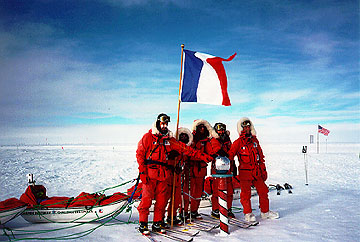
The French expedition, Group Militaire de Haute Montagne
Photo by Sandi Kolb.
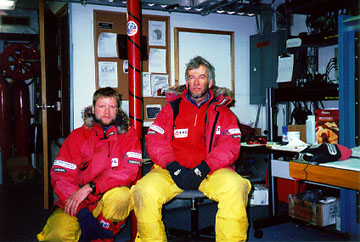
Coen Hofstede and Ronald Naar
Photo by Sandi Kolb.
Coen Hofstede, a 33 year old geophysicist, and Ronald Naar, a 43 year
old professional climber, photographer and author, from The
Netherlands arrived on Jan. 11th, the day after the French expedition
arrived. The Dutch Trans-Antarctic Expedition began their unsupported
adventure on Nov. 8th at Blue 1 in Dronning Maud Land (near South
Africa). They crossed over the Drygalsk Mountains covering a distance
of 2,200 km in 60 days before reaching the South Pole. Their original
goal was to continue to McMurdo via the Axel Heiberg Glacier to cover
a total distance of 3,780 km. Because they used parasails, calling
them kites, they planned their course according to favorable winds
versus straight line of travel and were unable to cover the distances
they hoped due to low seasonal winds. Although they continued skiing
from the South Pole a couple days later, they were not planning on
continuing the entire distance to McMurdo before asking for air pick
up. At their joint presentation with the French Expedition in the
galley on Jan. 12th, Ronald briefly mentioned their sponsorships
covering the $500-$600,000 costs of this expedition for two. Among
the 6 or more sponsors supporting them, he discussed the sponsorship
of a European aspirin company that was interestingly promoting the use
of one aspirin each day for the prevention of frostbite and high
altitude illness on such expeditions. Coen and Ronald, like Ohba, did
not switch over to New Zealand time while here. The evening before
they sailed off into infinity, they spent several hours chatting with
Les and me in Comms during our night shift. The web site address for
the Dutch expedition is: http://www.tpgantarctica.nl.
We are still anxiously awaiting the arrival of Icetrek, the Peter
Hillary (son of Sir Edmund) expedition group, supported by Antarctica
New Zealand (ANZ) making it a science event. In addition to Peter
Hillary, Eric Phillips and Jon Muir comprise this team of 3 trekkers
who are being sponsored by Iridium. They left Scott Base near McMurdo
on Nov. 4th and had planned to ski to the South Pole and return. This
round-trip was estimated to take a maximum of 100 days. However, they
have encountered many difficulties along the way and will not be
completing the return portion of their expedition. The latest
information our station manager has received on the Peter Hillary
party is that they expect to arrive here between Jan. 25, Monday, and
Jan. 27, Wednesday. You can follow their adventure at:
http://www.icetrek.com.
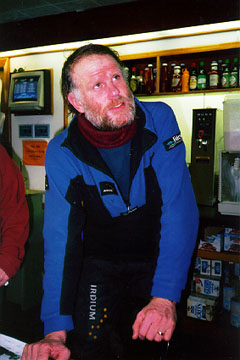
Peter Hillary
Photo by Sandi Kolb.
The month of January has been crammed with visits from the media. The
most obvious visit was the team of four from CBS. During their three
days at the South Pole it seemed as though they never slept as they
attempted to capture the science, construction and daily life of our
station. On the first morning of their visit, Les facilitated the CBS
request for a pre-recorded telephone broadcast from the Ceremonial
South Pole marker by staying after work to run many yards of telephone
wire outside, make the necessary connections and run the tests just
minutes prior to recording. This segment with Jerry Bowen in
conversation with the news anchor was to have been aired in the U.S.
on Sat., Jan. 16 from 7 to 9 a.m. EST. The longest segment will be
approximately 9 minutes and will air on "CBS Sunday Morning With
Charles Osgood" sometime in late February or early March. Although
the exact date remains undetermined, CBS will air promos the week
prior to airing. Looking ahead, CBS is working on releases for "60
Minutes" (changes in penguin populations and implications for humans),
"Evening News With Dan Rather" (global warming/El Nino effects and
tourism), "Weekend News" ( welcome to Antarctica and search for
extra-terrestrial life) and "CBS This Morning" ( women in Antarctica).
During the time CBS was here the French expedition arrived and we
experienced an extremely rare and gorgeous halo display in the skies
of Jan. 11th. (Halos are created by sunlight and ice crystals in the
sky.) Click on the Antarctica icon of the CBS web site at:
http://www.cbs.com/navbar/news.html to follow CBS in Antarctica.
During the week of Jan. 10th, four groups of journalists arrived.
Curt Suplee from the Washington Post was primarily interested in
writing about S. Pole science research projects and new station
construction. His arcticles are tentatively scheduled for publication
beginning in February. A writer from the New Scientist, Gabrielle
Walker, was mainly interested in astronomy and astrophysics and
station daily life. Bob Boyd from Knight-Ridder focused on astronomy
and astrophysics research while Jack Williams from USA Today was
primarily interested in climate and ozone monitoring, halos, and S.
Pole weather forecasting.
Early in the season there was a visit from congressional science
committee staffers who all have input for funding of the U.S.
Antarctic Program: Phil Kiko, Steve Eule, Skip Stiles, Mark Powden
and Suzanne Day. There have also been several visits from various NSF
(National Science Foundation) and ANZ (Antarctica New Zealand)
delegates. During the last week of January we are expecting DVs from
the U.S. Dept. of Energy as well as from the House of Representatives.
This weekend we are looking forward to a visit from the Chilean Air
Force arriving in two Twin Otters and a Blackhawk helicopter. This
will be an unusual experience as most of us have never seen a
helicopter landing at the South Pole!
Tourists are few and far between, but there are some each austral
summer. Tourists travel to Punta Arenas, Chile and are flown by a
private adventure company to their base camp at Patriot Hills,
Antarctica. After frequently waiting days for weather to clear, they
arrive by Twin Otter at the South Pole Station where they visit for
only about 3 hours before their return flight of approximately 4½ to 5
hours to Patriot Hills. I've heard from various people that the
company charges roughly $25,000 to $30,000 per person. This is in
addition to roundtrip travel costs to Chile from point of origin. As
far as I can tell there have been less than 10 tourists so far this
season.
Our South Pole web site address is: http://www.spole.gov. Here you
will find our up-to-the minute weather, latest flight schedule
(flights are mostly cargo for new station construction and standard
station resupply), satellite rise times (our live internet connection
to the world), movie data base, local science project links and USAP
(U.S. Antarctic Program) grantee web site list. Click on "Other South
Pole Events" and again on "Spectacular halo display at South Pole" to
see rare photos of the great South Pole halo display of Jan. 11th,
computer simulation, explanations and data. Under "What a New Year's
Day!" click on "Roger & Donna tie the knot!" and "Moving the
geographic pole" to see photos of these special events.
We are in the midst of an Antarctic storm. Early Thursday morning,
Jan. 21, I noticed from the weather observations I was reporting that
wind speed was increasing. Since then, visibility has been down to
400 meters with winds gusting up to 32 knots. Both inbound flights on
Thursday aborted due to weather and all flights were cancelled today.
The forecast does not look for improved conditions until Saturday
night. The skiway will need grooming before aircraft can land once
the storm clears.
Following is a 1998 summary of South Pole Station weather prepared by
station meteorologists Victoria, John, and Dar.
Best regards,
Sandi
amateur radio: NE7V
Sandra Kolb,ASA
South Pole Station
PSC 468 Box 400
APO AP 96598-5400
1998 Weather Highlights
January
January was marked as the cloudiest January on record. There were 25
cloudy days, breaking the previous record of 19 cloudy days set back
in 1971. The average temperature for the month was -27.8(C)/-18.0(F),
0.3(C)/0.5(F) warmer than normal. On the 30th, the average wind speed
of 16.1 mph/14.0 kts broke the previous record of 13.9 mph/12.0 kts
set back in 1958. A maximum temperature of -20.9(C)/-5.6(F) occurred
on the 9th. The minimum temperature of -39.2(C)/-38.6(F) occurred on
the 28th. The average wind speed for the month was 8.8 mph/7.6 kts
from grid-north. The maximum wind of 24 mph/21 kts occurred on the
8th. The average station pressure of 687.8 mb was 2.3 mb below
normal.
February
In February an upper level system brought low clouds,
freezing fog, and reduced visibility which threatened to delay station
closing on the 16th. Despite the marginal approach conditions, the
final flight of the season was able to land and depart as scheduled.
There were two new temperature records set during the month. On the
16th, a maximum temperature of -26.5(C)/-15.7(F) broke the previous
record of -29.3(C)/ -20.7(F) set in 1986. On the 17th, a maximum
temperature of -26.4(C)/-15.5(F) broke the previous record of
-29.4(C)/-20.9(F) set in 1958. The average temperature for the month
was -38.8(C)/-37.8(F), 2.0(C)/3.6(F) warmer than normal. The average
wind speed for the month was 9.2 mph/8.0 kts from grid-northeast. The
average station pressure of 685.3 mb was 0.6 mb below normal.
March
March was another unusually cloudy month, with a new record of 24
cloudy days observed. The temperatures during the month were near
normal with an overall average of -53.1(C)/-63.6(F). The average wind
speed was 11.3 mph/9.8 kts from grid-northeast. The average station
pressure of 679.7 mb was 1.9 mb lower than normal. Due to strong wind
speeds during the middle of the month, visibility was reduced to less
than 1/4 of a mile for five days straight in blowing snow. The
maximum wind speed for March occurred on the 15th at 24 mph/21 kts
from grid-north.
April
Clear skies and light winds brought colder
than normal conditions for the month of April, and six new record
minimum temperatures were set. During this record-breaking cold wave
there were 10 consecutive days and 15 total days where the temperature
remained below -68(C)/-90(F). On the 16th, the temperature dropped to
-73.9(C)/-100.8(F). There have only been two other times since 1957
when the temperature has dropped this low so early in the season. An
average monthly temperature of -62.4(C)/-80.3(F) was 5.2(C)/ 9.4(F)
colder than normal. The minimum temperature for the month of
-74.0(C)/-101.2 (F) occurred on the 23rd. Wind speeds were near
normal. The maximum wind speed of 26 mph/23 kts occurred on the 3rd
from grid-northeast. An average station pressure of 669.7 mb was 11.3
mb lower than normal.
May
The record-breaking cold wave continued into
the first week of May, setting three new minimum temperature records.
The minimum temperature for the month occurred on the 2nd, with a low
of -75.8(C)/-104.4(F), breaking the previous record of
-72.2(C)/-98.0(F) set back in 1977. The average monthly temperature
was -58.6(C)/-73.5(F), 0.5(C)/0.9(F) colder than normal. On the 4th,
a strong system moved over the area and remained stationary throughout
the latter part of the month, producing strong gusty winds, blowing
snow and near white-out conditions. During the month there were 9
days where the visibility dropped to a 1/4 mile or less in blowing
snow. Two new peak wind records were set this month. The maximum
wind occurred on the 17th at 40 mph/35 kts from grid-north. The
average pressure of 676.5 mb was 4.0 mb below normal.
June
In marked
contrast to the cold temperatures which occurred in April and May, the
month of June was warmer than normal. The average monthly temperature
of -55.9(C)/-68.6(F) was 2.5(C)/4.5(F) above normal. The maximum
temperature occurred on the 21st at -37.2 (C)/-35.0 (F). This
tied the previous record for the day set in 1962. Strong gusty winds
continued throughout the month, causing the visibility to drop to 1/4
mile or less in blowing snow for 6 consecutive days. The maximum wind
occurred on the 28th at 28 mph/24 kts from grid-north. The average
pressure for the month was near normal at 681.2 mb.
July
Strong gusty
winds, blowing snow and near white-out conditions continued throughout
the month of July. The high winds on the 10th brought the strongest
gust of the year at 43 mph or 37 kts, breaking the previous maximum
wind record for this day of 35 mph/30 kts set in 1981. There were 16
consecutive days where the visibility was 1/4 of a mile or less in
blowing snow. The average temperature for July was near normal at
-59.4(C)/-74.9(F). Two new record minimum temperatures were set during
the month. On July 7th, a minimum temperature of -74.7(C)/-102.5(F)
broke the previous record of -73.4(C)/-100.1 (F) set in 1959. On the
8th, a minimum temperature of -75.6 (C) /-104.1 (F) broke the previous
record of -71.8(C)/-97.2(F) set in 1987. The average pressure for the
month of 675.0 mb was 2.2 mb lower than normal.
August
Gusty winds continued into the month of August. The maximum wind
occurred on the 2nd at 32 mph/28 kts. There were 6 days where the
visibility dropped to 1/4 of a mile or less in blowing snow. The
average temperature for the month was -63.2(C)/-81.8(F). This was
3.5(C)/6.3(F) colder than normal. The minimum temperature occurred on
the 31st with -74.1(C)/-101.4(F). A monthly maximum temperature of
-46.9(C)/-52.4(F) occurred on the 8th. The average pressure was 673.8
mb, 2.4 mb below the monthly normal. There were no new records set or
tied during the month.
September
The month of September was colder
than normal with an average temperature of -63.6(C)/-82.5(F). This is
4.3(C)/7.7(F) below the monthly average. The minimum temperature of
-76.7(C)/-106.1(F) occurred on the 3rd, making this the coldest
temperature of the year. The windy conditions of July and August
continued during this month, with the maximum wind occurring on the
12th at 30 mph/26 kts from grid-north. Once again, there were near
white-out conditions in blowing snow. There were 9 consecutive days
where the visibility was reduced to 1/4 of a mile or less. The
average station pressure for the month was 676.5 mb, which was 1.2 mb
above normal. There were no records tied or broken during the month.
October
Following the trend of the two previous months, October's
average temperature of -55.0(C)/-67.0(F) was 3.8(C)/6.8(F) below
normal. In a span of four days between the 7th and the 10th, the
station recorded three record lows. These were the only records for
the month. Following that was a streak of four straight days with
visibility of 1/4 mile or less from the 12th to the 15th. A peak wind
gust of 29 mph/25 kts occurred on both the 12th and the 14th, while
the highest pressure of 697.0 mb was recorded on the 15th. Winds and
station pressure over the course of the month were near normal. As
the scheduled date of station opening approached, conditions as a
whole improved and the first plane arrived just two days behind
schedule.
November
The month of November was windier than normal with
an average wind speed of 14.4 mph/12.5 kts. The prevailing wind
direction was from grid-north. The maximum wind for the month of 42
mph/36 kts occurred on the 3rd, breaking the previous daily record of
35 mph/30 kts set in 1961. Additionally, daily maximum wind records
were tied on the 2nd and the 26th. Visibility of 1/4 of a mile or
less in blowing snow was observed on 5 of the first 6 days of the
month. The average monthly temperature of -37.6(C)/-35.7(F) was
0.7(C)/1.3(F) warmer than normal. November was also more cloudy than
normal, with 16 cloudy days observed. The average station pressure
was 679.0 mb, which was 3.4 mb lower than normal.
December
The
temperatures during the first week of December averaged above normal
with a record high set on the 1st of the month. The rest of the
month, however, saw only two more days with temperatures above normal
while unseasonably cold conditions dominated. Christmas day brought
the coldest temperature of the month at -34.8(C)/-30.6(F), also a
record for the day. Record lows were also recorded on the last three
days of the month. Fair weather prevailed throughout most of December
as the station saw above average sunshine and zero days with
visibility of 1/4 mile or less. The peak wind speed of 25 mph/22 kts
was recorded on both the 2nd and the 3rd, while winds for the month
were 1.9 kts below normal at 6.2 kts. The average station pressure of
684.4 mb was 4.1 mb below the normal of 688.5mb.
Month Temperature (C) Winds (Kts)
Dep.
From Avg Peak
Max Min Avg Normal Spd Dir Spd Date
January -20.9 -39.2 -27.8 +0.3 7.6 360 21 8th
February-26.4 -54.0 -38.8 +2.0 8.0 060 20 3rd
March -41.8 -64.3 -53.1 +0.9 9.8 040 21 15th
April -44.6 -74.0 -62.4 -5.2 9.6 090 23 3rd
May -34.9 -75.8 -58.6 -0.5 11.6 010 35 17th
June -37.2 -72.8 -55.9 +2.5 9.5 040 24 28th
July -44.4 -75.6 -59.4 +0.2 12.4 020 37 10th
August -46.9 -74.1 -63.2 -3.5 11.0 020 28 2nd
September-46.1 -76.7 -63.6 -4.3 9.8 080 26 12th
October -37.9 -66.8 -55.0 -3.8 10.1 010 25 12th
November-23.5 -48.8 -37.6 +0.7 12.5 020 36 3rd
December-22.2 -34.8 -29.0 -1.2 6.2 030 22 2nd
1998 Climatological Summary
>From January 1, 1998 Through December 31, 1998 UTC
Temperatures:
Avg Temp....................... -50.5 (C) / -58.9 (F)
Departure from normal... -1.1 (C) /-2.0 (F)
Max Temp...................... -20.9 (C) / -5.6 (F) on January 9th Min
Temp....................... -76.7 (C) / -106.1 (F) on September 3rd
Sky Cover:
Avg Sky Cover ............... 6/10th / 5/8th
Days clear... 104 Days partly cloudy... 96 Days cloudy... 164
Wind:
Avg wind speed.................. 11.4 mph or 9.9 kts
Departure from normal....... -1.0 mph or 0.9 kts
Max gust............................. 43 mph or 37 kts on July 10th
Max gust direction.............. From Grid Northeast Vectored wind
direction...... 048 degrees Vectored wind speed........... 7.7 kts
Prevailing direction............. Grid North
Station Pressure (millibars):
Avg pressure........................ 678.8 mbs
Departure from Normal....... -2.6 mbs
Highest pressure................... 699.2 mbs on January 14th
Lowest pressure.................... 654.7 mbs on May 2nd
Physio-altitude in feet and meters:
Average physio-alt = 10674 ft / 3253 m
Highest physio-alt = 11597 ft / 3535 m on May 2nd
Lowest physio-alt = 9912 ft / 3021 m on January 14th
Visibility:
67 days with visibility of 1/4 mile or less.
Prepared by: Victoria Campbell, John Gallagher, and Dar Gibson
Back to Letters.
|
